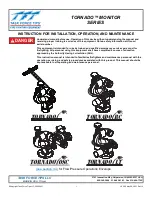
14
PNEG-250
Hi-Lo and PRO-1 Pan Feeders
4. Calculating Weight
The winching system used to raise and lower the feed system in the poultry house imposes additional load
on the building. It is essential to confirm that the building is able to carry this extra load. Consult a structural
engineer to check the building strength. Details of the likely weight of the feed system are given in the
calculations below. However, if there is any uncertainty, contact your dealer or Cumberland for assistance
with calculating the weight.
To calculate the weight of the pan feeding system, you must identify the weights of the following
components: A) hopper, boot and the feed they will hold, B) weight of tubing, pans, auger and the feed
they contain per section of tube and C) weight of control pan and drive unit.
A. From the
Capacities and Specifications Section on Pages 15
, find the weight of the hopper
(H) being used, the boot (BT) being used and the capacity (HP) of the hopper being used. Add the
weights of these three (3) components together: A = H+BT+HP.
B. Find the pan weight (PW) and the pan capacity weight (PC) using the
. Add these two (2) weights together and multiply by the number of pans
per tube section (NP) to get the total pan weight (TPW) per tube section. TPW = (PW+PC)(NP).
Next find the weight of the tubing (T) and auger (AG) being used from the
Specifications Section on Pages 15
. Note the tube length (TL). Feed weight (FW) in the tube
are: 10' of tubing will hold 3 lbs. of feed, 9' tubing holds 2.7 lbs. and 12' tube holds 3.6 lbs. Figure the
total weight per length of tube from the formula: B = T+(AG x TL)+FW+TPW.
C. Find the weight of the control pan (CPW) and drive unit (DU) being used from the
Specifications Section on Pages 15
. Add these two (2) weights together: C = CP+DU.
Calculating Weight of Feedline at Each Suspension Point
After determining A, B and C, determine the quantity of each component to be suspended by any
suspension point.
Determine Weight of Entire System
System weight (SW) is determined by adding the number of tubes in use (NT), number of drive units in
use (ND) and finding the total weight of A, B and C: SW = A+(B x NT)+(C x ND).
NOTE: Weight of feed calculated at 40 lbs. per cubic foot. If feed to be used is of different density, the
weight of the system must be adjusted appropriately.















































